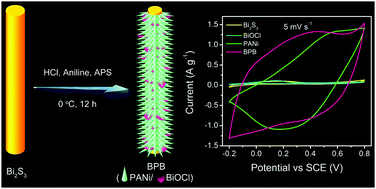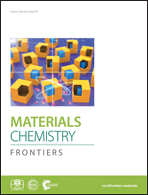One-dimensional polyaniline thorn/BiOCl chip heterostructures: self-sacrificial template-induced synthesis and electrochemical performance†
Abstract
A simple and green strategy was proposed for the first time to fabricate uniform polyaniline (PANi) thorn/BiOCl chip (BPB) heterostructures at a low temperature without the assistance of any surfactant. During the synthetic process, Bi2S3 nanowires acted as both the sacrificial template and the Bi source for BiOCl, affording the synchronous formation of HCl-doped PANi conductive arrays and BiOCl chips supported on residual Bi2S3 nanowires. As expected, when utilized as electrode materials for supercapacitors, the obtained BPB nanocomposite exhibited a better electrochemical performance in neutral media with enhanced specific capacitance, a more acceptable rate capability and a smaller charge-transfer resistance in comparison with the individual PANi nanofibers due to the unique hierarchical nanostructure of BPB and the synergistic effect between the ionizable BiOCl and the PANi chain.


 Please wait while we load your content...
Please wait while we load your content...